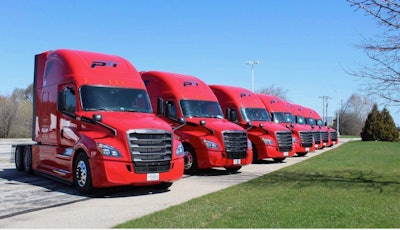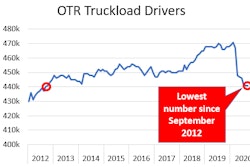
During the past six months, the driver shortage has gone from an afterthought to a major constraint on capacity.
Competition for experienced drivers is intense, and to compensate some motor carriers are directing recruiting efforts toward CDL students – even high schoolers.
Paper Transport, Inc. (PTI), a truckload carrier headquartered in De Pere, Wisconsin, has refined its three-week driver finishing program, Accelerator, and opened nearly all jobs to new CDL holders. Currently, about one-third of all driver hires are coming through Accelerator, said PTI Recruiting Operations Manager Mike Ruminski.
The foundation of the new recruiting strategy began in 2018 when PTI added a job assessment tool to the recruiting process from JOBehaviors.
[Related: CCJ Innovator Paper Transport takes 'leap of faith' with driver behaviors]
As part of the application process, drivers have to complete a 15-minute assessment online that uses a scientific method to evaluate human behavioral psychology. Recruiters receive an email instantly with results showing where a driver ranks within a five-star system. Each star corresponds to the driver’s percentile rank in behaviors that predict job success.
PTI only continues the recruiting process for drivers with a score of three stars and above.
“We are very confident in the result we are getting through the assessment,” Ruminski said.
PTI recently expanded its use of the Class 8 CDL assessment tool from JOBehaviors to determine which CDL students in Wisconsin to sponsor with $6,000 tuition grants. As part of the grant, drivers commit to work for PTI upon graduation. The company is planning to expand the grant program to key driver labor markets in other states.
About half of all CDL school students receive funding by carriers or by other means, Ruminski said. The assessment not only helps PTI determine which students to fund, but also helps students determine if they have the right characteristics for a successful career at PTI and in the industry, he noted.
Between 10% and 15% of recent drivers hired by PTI have come from CDL schools on scholarship. Overall results from the assessment and the Accelerator finishing program show that drivers can be as safe and proficient after six months on the job as drivers with six years experience, Ruminski said.
Adding another layer of qualifications thins the pool of applicants, however. In a recent week, PTI received 100 applications from drivers who were either recent graduates or still in school. Sixty applicants were deemed “not qualified” for various reasons, of which 35 scored less than 3 stars on the assessment.
Ruminski said he has found that people who score on the lower end typically have other qualification problems due to their MVR or work history, among other factors.
Predicting the next generation of drivers
Besides using the predictive tool to identify student drivers who are most likely to succeed, efforts are being made at the ground level to encourage high school students to pursue driving and other trucking careers.
At present, about 70% of high school students have no access to a college or career counselor, said Jamie Finch, chief business development officer of myKlovr, a company that developed a career assessment platform that students and professionals use nationwide.
MyKlovr recently added the JOBehaviors assessment tool to the platform. When a student or professional takes a short, 90-second career assessment, those who have key work qualifications are invited to take the JOBehaviors assessment to determine their likely success as a Class 8 CDL driver, Finch said.
The company is working with the American Trucking Associations and other trucking groups to provide leads from pre-qualified professionals and to provide information to students about the industry.
Patterson High School is another example of work that is being done at the ground level to recruit and train the next generation of drivers.
[Related: High school program puts students in the driver's seat]
Dave Dein is the CDL coordinator and instructor at the school in Patterson, California. Dein started teaching a CDL class in 2018. Recently, he worked with school administration to have a group of 135 eleventh grade students take the JOBehaviors assessment. He plans to use the results to encourage students with the right attributes to take the class and pursue trucking careers.
Overall, 22% of students who took the test scored three stars or higher. Interestingly, 48% of the students with the highest scores are female, he said, but only 4% of students who have taken his class so far have been female.
Dein's class combines classroom instruction with simulator training. At the end of the program, students can apply for a Commercial Learners Permit (CLP) and enroll in an adult education program that is paid for by district funds to attend an outside truck driving school for behind-the-wheel training.
Dein has also spent the past year creating a non-profit trade association to be called Next Generation in Trucking. The group will launch next month to begin working with schools nationwide to replicate his high school program and help change the image of trucking.












